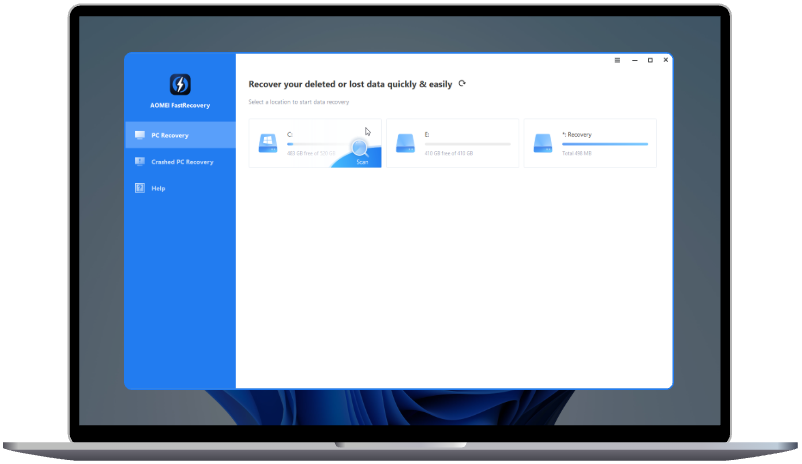[Fixed] Hard Drive Not Showing Up in Optimize Drives
The hard drive not showing up in Optimize Drives generally for seven reasons. This post covers the targeted solutions and the best alternative to the tool.
Help! The drive not showing up in Optimize Drives
" My computer is very slow when loading programs, so I tried to use Defragment and Optimize Drives to defrag my hard drive. However, the drive not showing up in optimize drives, why? Is there any solution here? Looking forward to your help."
Is your computer taking forever to load programs? You might need to defragment your hard drive to speed things up. Over time, files get split into fragments scattered across your drive, making your PC slower as it struggles to piece them together. Windows’ Optimize Drives tool is designed to fix this – but what if your hard drive not showing up in Optimize Drives utility?
This frustrating problem can happen for many reasons. The good news? Fixing it is easier than you think. In this article, we will introduce several straightforward solutions. Before fixing, let's get to know the reasons first for better solving.
Why does the drive not showing up in Optimize Drives?
The hard drive not showing up in Optimize Drives utility can be various. Here are some common reasons that cause the issue. You can try each targeted solution step by step to resolve the issue more effectively.
| Possible Reason | Explanation | Solution |
|---|---|---|
| 1. Drive Not Properly Connected | Loose cables, faulty ports, or power issues prevent detection. | Check connections, try different ports/cables, ensure external drives are powered. |
| 2. Uninitialized/Unformatted Drive | New drives must be initialized and formatted before use. | Initialize the disk to MBR or GPT and format (NTFS recommended). |
| 3. Missing/Conflicting Drive Letter | Drive lacks a letter or conflicts with existing assignments. | Assign a unique drive letter via Disk Management > "Change Drive Letter and Paths". |
| 4. Unsupported File System | Optimize Drives skips exFAT or non-NTFS/FAT drives. | Reformat the drive to NTFS (back up data first). |
| 5. Drive Errors or Corruption | File system errors or bad sectors on the hard drive prevent recognition. | Run chkdsk X: /f (replace X with the drive letter) in Command Prompt. |
| 6. Outdated/Corrupt Drivers | Drivers are deleted, missing or outdated. | Update drivers via Device Manager or the manufacturer’s website. |
| 7. Failing Drive | Physical damage or impending failure causes detection issues. | Replace a new disk. If you want to reserve all the data, you can clone the hard drive first. |
If you think it is troublesome to fix hard drive not showing up in Optimize Drives utility, you can use its best alternative, AOMEI Partition Assistant. This multifunctional software supports both solving that issue as well as providing the alternative for enhancing drive performance.
The best alternative to optimize your drives: defragging disk
No matter how powerful a computer is, it slows down over time. One reason is file fragmentation. At first, data is arranged neatly, but installing and deleting programs scatters file fragments. This makes the system take longer to find data, causing your PC slow all of a sudden. Many users try to fix this by using Defragment and Optimize Drives but find their hard drive not showing up in defrag. Luckily, AOMEI Partition Assistant offers the best alternative to Optimize Drives utility.
AOMEI Partition Assistant provides a clear interface, allowing you to easily defragment drives, including external devices, in just a few steps. You can schedule defragmentation by setting the time and fragmentation level. No need to worry about mistakes—you can preview the results beforehand.
Besides, you can use some advanced features to manage your PC drive better, such as allocating free space, migrating OS to SSD, moving application from one partition to another, converting dynamic disk to basic, etc.
The Best Windows Disk Partition Manager and PC Optimizer
Step 1. Download and run AOMEI Professional, right-click the disk, then select the "Disk Defrag" option.
Step 2. Select the target drive and click "Analyze".
Step 3. To defrag the hard drive regularly, please click "Schedule".
Step 4. Select the target drive, then set the time to defrag it, then click "OK" to save all settings. Click "Conditions", then you can set the degree of the fragmentation.
Step 5. There're other options to make a detailed schedule, when you set all, click "OK" to the next step.
Step 6. Click "Defrag" to defrag your target drive.
🔥Follow up: Optimize SSD by 4K alignment
Due to the difference between SSD and HDD, you cannot directly use "Disk Defrag" to SSD when it is slow, because defrag SSD may shorten its lifespan.
Here, AOMEI specially prepared the "Partition Alignment" function for you to optimize the SSD. In a few simple steps, it can align 4K sectors on SSD to make it run faster.
Step 1. On the main interface, right-click a partition from the SSD, then select "Advanced" and "Partition Alignment".
Step 2. In the "Partition Alignment" window, select "4096 Sectors".
Step 3. Click "OK" and "Apply" to start aligning the target partition. Repeat the above operations to align the remaining partitions.
Other alternatives when hard drive not showing up in optimize drives
When the optimize drives are not available, you can use the 2 alternatives as well.
Option1. Use the chkdsk /f command of CMD
If you find that the target disk is not displayed in optimize drives, there may be an error with your hard disk. Thus, you can use the Command Prompt to check disk.
CHKDSK is a command-line tool, specially used to check the hard disk file system and repair a series of hard disk errors in the Windows system. You can also use it to check for bad sectors, fix blue screens, etc. Please follow the steps below.
Tip: If the target drive is in use, you will not be able to successfully check and repair it, so please make sure you have turned off the target drive.
Step 1. Press "Windows + R" simultaneously, then type "cmd" and press "Enter".
Step 2. Type "chkdsk /?" to know the details in advance.
Step 3. Enter "chkdsk X:" (X refer to the drive you want to check.) to check the integrity of the target drive; enter "chkdsk g: /f", you can find out and repair any errors in the target drive. Here we take G drive as an example.
Option 2. Try the command line version of defrag
After checking and repairing the target partition, if you still cannot find the target drive in defrag drives, you can use the command line version of defrag. The detailed steps are as follows:
Step 1. Press "Windows+R", enter "cmd" in the Run program and press "Enter".
Step 2. If the C drive not showing in defrag, enter the "defrag c: /A“ command in the CMD window and press "Enter".
Tidy up
Look, in this article, we have shared three solutions to hard drive not showing up in optimize drives. With the help of AOMEI Partition Assistant, you can easily run disk defrag in HDD; for SSD, you can also align its partitions to improve its performance. By the way, we also prepared the Server Edition for Windows Server users to defragment hard drive.

